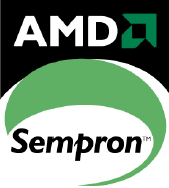AMD Sempron: A Fresh Take on Budget Computing
by Derek Wilson on July 28, 2004 12:01 AM EST- Posted in
- CPUs
Introduction
The competition in the processor market has been fierce ever since the first Athlon processors were released in the fall of 1999. In the time since then, AMD and Intel have each led and followed at different times. We have seen each company develop its strong points and grow. This release marks the next evolution for AMD in an area in which they have been very solid since even before the Athlon's release: budget computing.Today, AMD is introducing a processor to span the market between their long running Socket A platform and the first Athlon 64 platform, the Socket 754. AMD has quite a lot of experience with these two product lines, and it has been very cost-effective for them to reuse pre-existing technology in a new form at a much lower price point than current generation technology. And based heartily in that philosophy, we present the AMD Sempron line of budget processors.

AMD's Sempron logo
The Sempron processors, as we mentioned in this AnandTech Insider article last month, is AMD's "ron" placement to the Duron processor. The name is derived from the Latin word, Semper (meaning "always"), and the tech suffix -ron (which apparently means "budget processor"). Sempron should fall at a lower performance point than equivalent rated parts from other AMD processor lines. As this processor spans two platforms, it makes sense to compare the new Sempron to both the Athlon XP line of processors and current Athlon 64 processors. And as Sempron is a budget processor, it makes sense to compare it to Intel's budget line of processors.
While we've seen multiple architectures with similar names, to some extent, in the past, consumers will have to know this time around that their Semprons from 2800+ and down work with socket A platforms, and 3100+ and up work with socket 754 or even 939 in the future. Obviously, the pertinent information will be somewhere on the box or product description, but it would be nice if AMD could make this more clear through the name of the product.
We do understand the usefulness in having a single name under which to sell, but we're not quite convinced that the benefits outweigh possible consumer confusion in an already complex marketplace.
In the following pages, we will take a look at our standard budget CPU performance tests. As these processors are designed for budget markets, special attention will be paid to price/performance throughout the article. But first, let's take a look at the silicon behind the name.
UPDATE: The pricing info we recieved was altered at launch. AMD decided to raise their prices by over 17% on the low end (the 2400+ is up to $61 from $52), and between 5% and 6% on the high end (both the 2800+ and 3200+ prices are up $6). These small dollar ammount pricing changes make a large difference on budget processors and impact price/performance analysis quite a bit. Had we recieved pricing information on par with AMD's current numbers, we wouldn't have been quite so enthusiastic about Sempron's price/performance advanatge over Celeron D. At this point, the only price advantage Sempron has over Celeron is the higher availability of cheaper motherboards.
On a positive note, AMD has confirmed our suspicion that the NX bit and Cool'n'Quiet features of Athlon 64 will be available in K8 versions of the Sempron (3100+ and higher). The only A64 feature disabled in Sempron is x86-64.










55 Comments
View All Comments
Pumpkinierre - Wednesday, July 28, 2004 - link
Good to see the loss of cache having little effect. From 1Mb to 256K of L2 there would be barely 5% loss in overall performance even in cache biased demos and benchmarks and probably less in real gaming. 256K of L2 is right on the money, all that is needed is the S939 flavor with the dualmemory channel and a lasting socket. The a64 will show its true colours in data streaming activities once software is written or compiled for it rather than P4 biased software. cant wait to see the overclock.Zebo - Wednesday, July 28, 2004 - link
Looks like there's going to hardly a difference between a Celeron 335 and Sempron 2800+.---------------
Comparing the top celeron to middle of the road athlon on a old socket A? Comparing a more expensive celeron to a less expensive sempron...
Hardly equitable. Look at the benches comaring competing processors. The 3100+ scores a, to use your words, 'WE PWNED INT3L OMG!!!' victory of 20+ % almost accross the board.;)
ncage - Wednesday, July 28, 2004 - link
the overall value comes in upgradability. You can buy a socket 754 mb + sempron processor and be able to upgrade to an amd 64 chipset without upgrading your mb. So i think its awesomebearxor - Wednesday, July 28, 2004 - link
I don't know...Looks like there's going to hardly a difference between a Celeron 335 and Sempron 2800+.
I don't think anyone could sit in front of either of these processors and tell a real-world difference.
While this looks like a victory for AMD, I think its really slim victory and not much of a 'WE PWNED INT3L OMG!!!' victory.
No doubt the overall cost of the Intel system will be higher, but will it matter for OEM's like Gateway/Compaq, etc?
I imagine we'll see systems using both from most manufacturers but the only downfall I see here is that regardless of which system you choose, you're already outdated with a very minimal upgrade path.
Zebo - Wednesday, July 28, 2004 - link
Awesome!